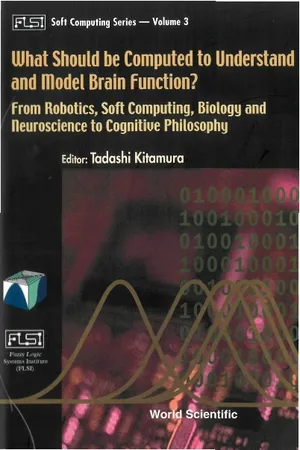
What Should Be Computed To Understand And Model Brain Function?: From Robotics, Soft Computing, Biology And Neuroscience To Cognitive Philosophy
From Robotics, Soft Computing, Biology and Neuroscience to Cognitive Philosophy
- 324 pages
- English
- PDF
- Available on iOS & Android
What Should Be Computed To Understand And Model Brain Function?: From Robotics, Soft Computing, Biology And Neuroscience To Cognitive Philosophy
From Robotics, Soft Computing, Biology and Neuroscience to Cognitive Philosophy
About This Book
This volume is a guide to two types of transcendence of academic borders which seem necessary for understanding and modelling brain function. The first type is technical transcendence needed to make intelligent machines such as a humanoid robot, an animal-like behavior architecture, an interpreter of fiction, and an evolving learning machine. This technical erosion is conducted into areas such as biology, ethology, neuroscience and psychology, as well as robotics and soft computing. The second type of transcendence of cross-disciplinary boundaries cuts across scientific areas such as biology and cognitive science/philosophy, into comprehensive, less technical and more abstract aspects of brain function. These aspects enable us to know in what direction and how far an intelligent machine will go.
Frequently asked questions
Information
Table of contents
- Contents
- Series Editor's Preface
- Volume Editor's Preface
- Chapter 1 Consideration of Emotion Model and Primitive Language of Robots
- Chapter 2 An Architecture for Animal-like Behavior Selection
- Chapter 3 A Computational Literary Theory: The Ultimate Products of the Brain/Mind Machine
- Chapter 4 Cooperation between Neural Networks within the Brain
- Chapter 5 Brain-like Functions in Evolving Connectionist Systems for On-line Knowledge-Based Learning
- Chapter 6 Interrelationships, Communication, Semiotics and Artificial Consciousness
- Chapter 7 Time Emerges from Incomplete Clock Based on Internal Measurement
- Chapter 8 The Logical Jump in Shell Changing in Hermit Crab and Tool Experiment in the Ants
- Chapter 9 The Neurobiology of Semantics: How Can Machines be Designed to Have Meanings?
- Chapter 10 The Emergence of Contentful Experience
- Chapter 11 Intentionality and Foundations of Logic: A New Approach to Neurocomputation
- About the Authors
- Keyword Index